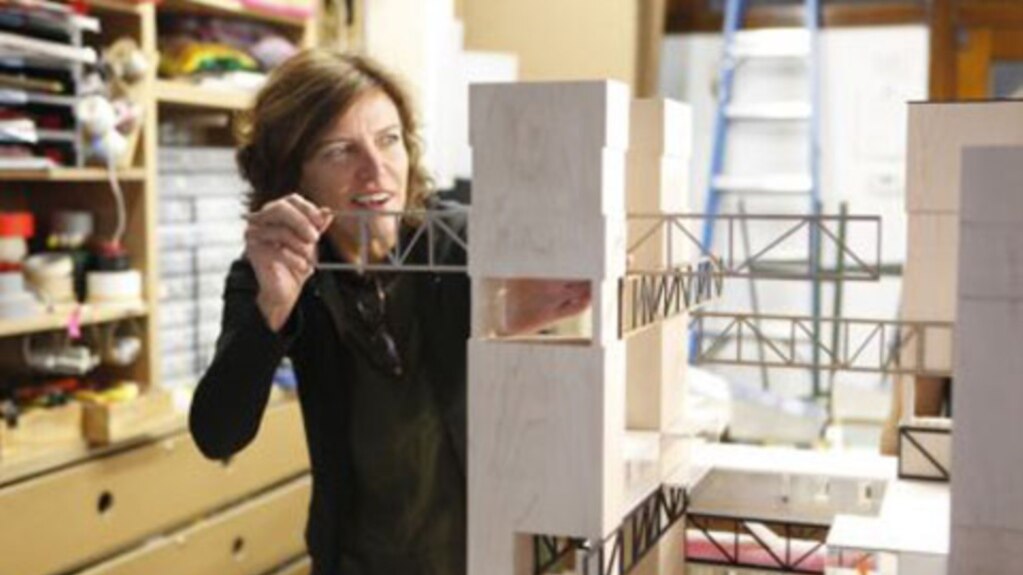
DOUG JOHNSON: Welcome to AMERICAN MOSAIC in VOA Special English.
(MUSIC)
I’m Doug Johnson. Today we listen to new music from the Red Hot Chili Peppers…
And we visit an unusual New York City park that lies more than seven meters above the island of Manhattan.
But, first we tell about a building designer who just won a big prize.
(MUSIC)
Jeanne Gang
DOUG JOHNSON: This week, the John D. And Catherine T. MacArthur Foundation named its MacArthur Fellows for twenty-eleven. Winners of this honor will receive five hundred thousand dollars over the next five years. The Foundation says its Fellows program honors explorers and risk-takers for doing interesting and inventive work.
Among the winners is building designer Jeanne Gang of Studio Gang. The MacArthur Foundation praised the Chicago-based architect for a “wide range of striking structures.” Faith Lapidus has more about Jeanne Gang and her work.
FAITH LAPIDUS: Forty-seven-year-old Jeanne Gang is one of the few women among major architects of today. She is famous for her skill at tying together beautiful design with serviceability. Jeanne Gang also is known for her environmentally safe and sensible development. Her goal is to work with and improve the natural surroundings in which she works.
Jeanne Gang studied architecture at Harvard University. She continued her education at the ETH Swiss Federal University of Technical Studies in Zurich Switzerland. She also worked with Dutch architect Rem Koolhaus in Rotterdam before opening her own company.

Jeanne Gang’s most famous structure to date is Aqua, in Chicago, Illinois. The eighty-two floor building was completed in two thousand ten. It includes more than one hundred seventy-six million square meters of floor space. Aqua has both homes and offices, and even a hotel.
The building is shaped like a rectangle that has been stretched in places. The areas sticking out are actually balconies. They are a mix of sizes and curvy shapes. These outdoor spaces create a waviness that looks like water.

However, the wavy design also helps ease the effects of Chicago’s winds. The shape helps to keep the building stable in high winds.
Studio Gang has launched other projects in Illinois, Kentucky and South Carolina. And the company is working with developers around the world. There are plans for projects in Canada, Germany, India and Taiwan.
Jeanne Gang says she became interested in architecture after seeing ancient cliff shelters in the mountains of Colorado. She says another major influence was her parents. Her father was a civil engineer who would take the family to see interesting bridges. Jeanne Gang says seeing her mother work with cloth also was an important influence.
Ms. Gang says architecture explores the use of materials for different purposes. She told the Chicago Tribune newspaper that before starting a project, she thinks about the materials that will be used first.
(MUSIC)
High Line Park
Astronomers of all ages plan to gather on Tuesdays next month at an unusual public park in New York City. Members of the Amateur Astronomers Association will be studying the planet Jupiter from the High Line, a park on the west side of Manhattan. But they will be a little closer to their subject than many other New Yorkers.
The High Line was built on a former railroad line. It sits more than seven and one half meters above the ground.
The astronomers will be among thousands of people enjoying the park-above-the-streets this autumn. High Line visitors take walks, see sights, take pictures and enjoy flowers and plantings. Or they might just sit and rest while they look at the nearby Hudson River.
The High Line is almost two–and-one-half-kilometers long. The area was once home to freight trains. They carried meat, milk, produce and other goods to upper-level loading areas at factories and storage centers.
Ten years ago, it appeared that the old rail line would be torn down. New York’s mayor at the time, Rudolph Giuliani, wanted to improve the neighborhood. His administration did not think what remained of the old railroad area was worth keeping.

But activists worked hard for permission to create a public park. And today visitors can walk the High Line by factories, restaurants, hotels, huge signs and crowded streets. They also can see tracks from the old rail line.
The line opened in the nineteen thirties. But it was rarely used after the middle of the last century. An arts administrator and train lover bought part of the over-the-street structure during the nineteen seventies. Peter Obletz paid the railroad company Conrail ten dollars for a piece of the line. He wanted to redevelop it for railroad use.
Mister Obletz spent five years attempting to do that. But he lost legal battles with governments and courts. He died in nineteen ninety- six without meeting his goal. But some people praise him for wanting to save some of the former rail line – a piece of New York history.
People from the community later worked to develop another goal. In nineteen ninety-nine, activists formed a group to develop the land as a park. They succeeded in getting New York City to take control of the line six years later.
The group, Friends of the High Line, is a non-profit organization that provides seventy percent of the park’s yearly operating budget.
Work to develop the first part of the park began in April of two thousand six. The space included the land from Gansevoort Street to Twentieth Street. It opened in two thousand nine. The second area that was developed is between Twentieth and Thirtieth streets. It opened in June.
A woman from Illinois recently walked on the Hi Line. She said she was especially interested in the many wild flowers. She said, “I feel like I’m on a floating garden.”
(MUSIC)
Red Hot Chili Peppers
DOUG JOHNSON: The Red Hot Chili Peppers is an old band with a new sound. The group recently released its tenth studio album, called “I’m With You.” Lead singer Anthony Kiedis says the new album shows the Red Hot Chili Peppers have become a new band. He uses words like “different chemistry” and “different experience” to describe the group. Much of this change, he says, has to do with the band’s new guitarist. Christopher Cruise has more.
(MUSIC)
CHRISTOPHER CRUISE: That was “Factory of Faith” from the Red Hot Chili Peppers new album “I’m With You.” The band has been recording music since nineteen eighty-four. But five years have passed since the group’s last album.
The band’s members have faced many changes since two thousand six. Singer Anthony Kiedis had a son. Bass player Flea used his time off to take musical theory classes at the University of Southern California. And guitarist John Frusciante left the group in two thousand nine.
The band’s new guitarist is thirty-one year old Josh Klinghoffer. He has worked with Beck and other performers, including Gnarls Barkley, and P.J. Harvey.

Anthony Kiedis describes the Red Hot Chili Pepper’s new sound as more complex, layered and dreamy. Here is “The Adventures of Rain Dance Maggie.”
(MUSIC)
The Red Hot Chili Peppers are performing this week in Brazil. They will spend the next few months traveling around Europe to perform their new music. We leave you with “Monarchy of Roses.”
(MUSIC)
DOUG JOHNSON: I’m Doug Johnson. Our program was written by Dana Demange, Jeri Watson and Caty Weaver. If you have a question about American life, send it to mosaic@voanews.com or click on the Contact Us link at voaspecialenglish.com. You can follow us on Facebook and Twitter at VOA Learning English.
Join us again next week for music and more on AMERICAN MOSAIC in VOA Special English.
(MUSIC)


